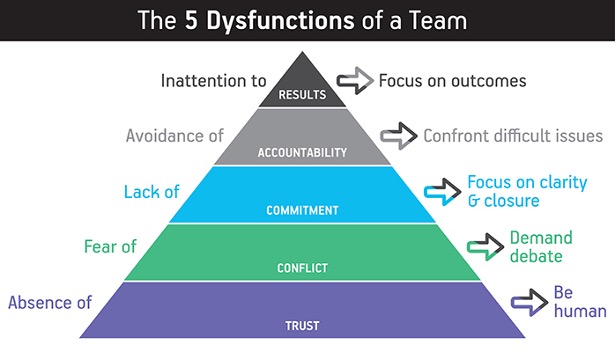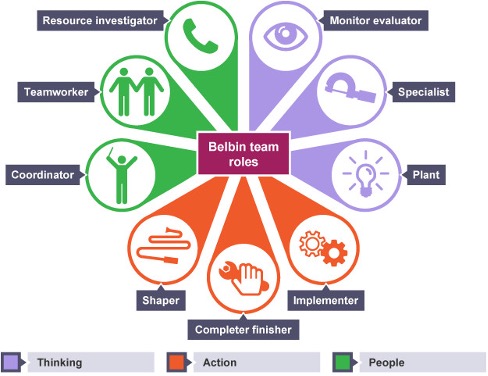Generally, we spend at least 1/3 of our precious time at work.
And so often, we find ourselves working in teams that don’t quite seem to be efficient and successful. And oftentimes, we can’t really point the finger at what is going wrong.
Welcome to the world of dysfunctional work relationships and dysfunctional teams. We all have experienced it, yet very few of us have practical solutions to solve it. Therefore, I want to share my experience and knowledge as a team coach with you, so you no longer spend 1/3 of your life on an inefficient and often unhappy team.



Why do teams fail ?
Before talking about solutions and how we can fix relationships that are off, we first have to ask: “What went wrong?”.
A great source of wisdom to answer this question is the book “5 Dysfunctions of a Team” by Patrick Lencioni. Lencioni depicts the various elements of “failure” in a pyramid. And the foundation that often causes teams to fail is a lack of trust, he says. We are all human and we never really enjoy admitting our weaknesses and mistakes. Yet, not being honest about your own abilities, hiding facts, not telling the truth, and not asking for help are great detriments to a good foundation.
Secondly, we often see the problem in people’s search for harmony. No one enjoys conflicts, yet they can be highly effective, especially in the work environment. If a team, for instance, lacks honest and constructive discussions and clear feedback, how can you possibly stay on track and evolve in a meaningful direction?
Just as destructive is the lack of commitment. I believe, we have seen this all at one point in our careers. Some teams just lack general common sense in decision making and, therefore, don’t follow along as a team. This is a great problem when it comes to achieving results and improving work efficiency.
Another great phenomenon that is often seen in groups is the lack of responsibility within the individual. The larger the group gets, the greater the lack. Not only does the individual now struggle to see his or her own significance in the project and is unable to clearly define his or her own work, but the problem is also rooted in a lack of the other perimeters. If there is no trust and no common decision making, how could a person take responsibility for something they don’t feel part of and potentially never agreed on?
This leads to the next problem that we can often find within teams. The lack of common goal orientation. We could say, we have a “team” of individualists. If everyone acts upon their own personal interests and what they believe is best, everyone will try to save his or her own seat instead of collaboration as a team.
As you see, there are many roots to look at to discover what exactly went wrong for your team. Do not skip this part. If you never find the root of the problem, everything you’ll do to solve it will just end up as a quick fix instead of a long-term solution.


Free Guide for setting healthy boundaries
Feeling overwhelmed? It’s time to set healthy boundaries in your life, relationships, and career! 🧘♀️✨
1. Start at the root – Building common ground
Do you try to build a house on sand or on solid ground? This is the question we have to aim for in this situation. If the very foundation of a team is crumbling, the only way to work your way out of dysfunctional work relationships is to start at the very bottom.
Build a proper foundation for your team; build trust. Allow the team to get to know each other and not only on a technical or functional level. This allows them to see each other’s personality.
Therefore, encourage the whole team to take the 16-personalities test or the Belbin Team Roles. Whatever works best for your team.
Because how can they ever feel safe in the team and begin to work as a union if they don’t trust each other?
2. Common Values - a novel approach to developing clear visions within a team.
If you have successfully been able to build a sense of trust in your team, you may have everyone think about their values. Because if everyone has different values they live by and work by, it’s obvious why there is a lack of common decision-making.
For instance, try this value exercise:
Use a card deck with values, and allow the room for everyone to find three value cards that resonate with them and represent them individually. Secondly, bring the team together and have them agree upon four values as a team in an open discussion. Make sure that everyone gets the chance to explain their understanding of the value and how they want to establish it. Questions that you may want to ask are: How do we understand this value? Where are we already living this value? What could we do to improve this value in our daily business?
See if this exercise helps you shift the energy within the group from dysfunctional to functional. If you have tried this, feel free to let me know via DM on Instagram @nadine.holisticelements how it went.
3. Communication is key – and this doesn’t end at the workplace
We all know from our private lives that if we don’t communicate clearly, honestly, and openly with one another, our lives will be painfully hard. You will find yourself in constant conflict, discussions, and fights. So why do we forget about this at work? It’s no different within teams.
Another way to increase the team’s satisfaction and their relationships with one another is to encourage an open feedback culture with 360-degree feedbacks, team feedback, and regular check-ins with colleagues. Give them space and time to communicate openly, honestly, and directly with each other.
It’s very helpful, for instance, to host a seminar on non-violent communication. We are human, we get emotional. We get loud, and that is okay. Yet sometimes, this makes life complicated for no reason. Therefore, it’s a great idea to teach each team member about a style of communication that is efficient, constructive, and honest, so they know how to solve problems without losing time in fights. Additionally, you could increase the basic conflict management skills of the whole team through training and workshops.
4. What if we fail? - let go of your fear of failure.
A great asset that high-functional teams have is the failure-tolerance culture. Everyone fails at some point, and taking the shame and fear away from it opens new room for ideas, creativity, and innovation. So, do your best to make failure a friend and help the whole team let go of shame, guilt, and fear around it.
5. Methods of Inspiration
If your team lacks any of the elements above, I want to share some more simple methods with you that can help improve the functionality of your team.
1) Setting common goals
- Vision workshops and regular OKR meetings +
- Goal: Understanding the common vision, purpose, and goal, as well as how each individual can contribute to it, is the goal.
2) Transparency of teamwork
- Task boards
- Goal: This helps committing to tasks.
3) Shared responsibilities
- Splitting responsibilities
- Goal: To assist everyone in participating in the process and seeing their meaningful work in the larger picture.
4) Who belongs to the team?
- When it is clear who is part of the team, it helps prevent dysfunction
- Goal: Help everyone identify with the team to improve functionality (i.e., value cards).
5) Appreciation
- People who feel appreciated work smarter, harder, and better.
- Goal: Make a point of regularly thanking each member of the team for their contributions.
- If you want to have detailed information about appreciation, stay tuned. There will be a blog article coming soon.
6) Efficiency
- If you want to know what makes an effective team and how to build one, there is another article coming soon that mentions the Google re:works study 2015.
So, what can I do?
What if I only take one piece home today?
If you only take one piece of advice home today, please speak up if you see the signs of dysfunctional relationships in your workplace. Speak up and get ready to change the dynamic.
You will not only save countless hours of work, money, and energy. You will transform the workplace into a place of creativity, inspiration, and innovation.
Warmest,
Nadine
PS: If you need professional help from an experienced team coach, feel free to reach out to me. I am happy to help!




